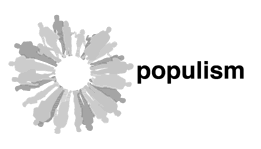Populism at the Stedelijk Museum: Reactions from the Press
By Leontine Coelewij
A stream of reviews, articles, and essays appeared in the Dutch and Dutch-language press in reaction to the exhibition “Populism” at the Stedelijk Museum, Amsterdam (30 April – 28 August 2005). * On the whole, the responses of the press concentrated on a number of aspects. The theme of “populism” was placed within the current socio-political context, particularly in the Netherlands, which led to the question of how topical the exhibition was. Most critics also considered how the theme of the exhibition had been explored and both the “broad” approaches of the curators and the works exhibited themselves were scrutinised thoroughly.
Critics often mentioned the same artists in their – generally positive – reviews, with pieces by Martin Le Chevallier (“exceptionally powerful” and “absolutely hilarious”), Erik van Lieshout (“witty”), Julika Rudelius (“shocking” and “fascinating”), and Sarah Morris (“terribly beautiful”) being singled out for particular attention. Jeremy Deller was described by Kees Keijer in Het Parool (30 April 2005) as the artist who “is perhaps most successful at combining a number of political, social, and artistic standpoints in a single piece,” thereby creating a “striking metaphor for the social and political movements of our time.”
Indeed, the Dutch critics were very divided in their opinions about the works exhibited. Keijer praised the exhibition in that the art works were not used merely to illustrate the overall theme. Sandra Spijkerman (Trouw, 6 May 2005) said that the “organisers have succeeded in presenting the selected theme in a visually appealing way,” and that “some pieces are a treat for the eyes; others show a generous dose of humour. There are no irritating wagging fingers here.”
Sandra Smallenburg (NRC Handelsblad, 6 May 2005) wrote that “Populism” was a “rich and varied exhibition that has much more to offer than one can handle in a day.” Paola van de Velde also spoke in positive terms in De Telegraaf about the design of the exhibition: “Although the theme could easily have made the exhibition as heavy as lead, the selection of artists – with an optimistic attitude towards life, an understanding of the place of humankind in the world, and a good sense of humor – has in fact given ‘Populism’ a certain degree of lightheartedness.”
The critics from HP/De Tijd (20 May 2005) and De Groene Amsterdammer (13 May 2005), however, were more negative in their opinions. Ron Kaal described the exhibition as “protest art,” in which “the message is just as simple as the packaging.” As an example, he cited the work of Willem de Rooij, in which, according to the critic, “nothing is analysed” and the video by Jakob Boeskov, which Kaal described as “playful and completely following the recipe of the sixties and seventies.” The critic claimed that he wanted to see more “real art” in the exhibition, criticizing most of the work for being “one-dimensional” and wondering whether these pieces should rather be exhibited in the context of a museum and not on television. According to him, the works were not adequately “transformed into something special, into a work of art. They remain documents.”
Xandra Schutte also appeared to have difficulty with many of the contributions to the exhibition, describing the works as not “alluring” enough. Considering the attitude of many of the young artists to be too similar to that of their activist predecessors from the sixties and seventies, “The message they generally seem to be conveying is ‘Populism is bad’. (…) Although there have been years of debate about the blurring of the differences between left and right, many of these young artists still exhibit an old-fashioned left-wing Pavlovian reaction.”
Some writers, such as Margriet Schavemaker and Domeniek Ruyters, referred to the “non-populist” character of the exhibition. Peculiarly enough, precisely because it did not try to provide simple answers to complex issues, Schavemaker (Vitrine, July–August 2005) criticized the exhibition for seeking more nuance and ambiguity and was, therefore, anti-populist in character. The result of this approach was, according to her, confusion: “Which is of course great, because that confusion sets you thinking about a complicated, but extremely relevant and topical theme.” These critics had evidently expected to see more populist art, such as Koons and Kostabi. Schavemaker referred to artists who “try to win over the public in a populist way with easily digestible, flashy images, and catchy one-liners.”
Domeniek Ruyters (De Volkskrant, 12 May 2005) also appeared to see the lack of “populist” art as a shortcoming. He remarked upon the non-populist approach to the theme for several reasons; partly because of the “lack of charm,” but, at the same time, he praised the show because the art was “far from transparent,” with the exhibition being full of “hidden meanings and irony.” According to him, the introduction of fine nuances within the safe walls of the museum can lead to the taming of the “monster” of populism. “This intellectual encapsulation is, of course, the sweet revenge of the intelligentsia on the masses who thought they ruled the roost of Europe.”
When the relationship between the “Populism” exhibition and the current socio-political situation in the Netherlands and Europe was mentioned, various critics naturally referred to the emergence and popularity of Pim Fortuyn and the LPF, but some also referred to the founding of a new populist party by crime reporter Peter R. de Vries during the week of the opening (at the end of April 2005) or to a more historical event that took place while the exhibition was on: the Dutch “No” to the European Constitution on 1 June 2005, “a triumph for populists from both left and right” (Sven Lütticken, “Postpolitiek, pop en populisme,” [Post-politics, pop, and populism] De Witte Raaf, July–August 2005).
But in general, most critics stated that the theme of populism had a great deal of topicality and immediacy. Only Domeniek Ruyters in the Volkskrant (12 May 2005) stated that populism was, in his opinion, past its sell-by date: “The curators (…) claim that they want their project to feed into and deepen the discourse around populism. But doesn’t this attempt come too late in the day for a society that is by now sick and tired of the populist twaddle spouted by incompetent political parties?” Ruyters referred to the appeal that was made three years ago during the opening of Documenta 11 for an end to all populist parties in general. “At the time, there were frantic discussions about the threat of censorship caused by the rapidly rising populist political parties, which, as we can now see, have prompted nasty incidents here and there, but not on a large scale, as was feared back then. Fundamentalism has thus far proved to be a greater threat to the freedom of expression, as the Netherlands has now experienced in their own backyard.”
The most in-depth analysis came from Sven Lütticken, who in his article “Postpolitiek, pop en populisme” (De Witte Raaf, July–August 2005) placed the exhibition and the reader in the broader context of the Dutch and European “post-political” situation. He referred, for example, to the slogan “Minder Politiek” (Less Politics) used by the SP (Socialistische Partij) during the campaign leading up to the referendum on the European Constitution in June this year and to the recent “referendum cult” in the Netherlands, intended to bring about a more direct form of democracy. Emphasizing the role of contemporary art within the modern culture industry, Lütticken stressed the potential of the exhibition as a catalyst for further discussion: “The best pieces in the ‘Populism’ exhibition contain the promise that art makes visible what mass culture represses, filters out, and distorts, and that art, within the culture industry at the very least, generates different experiences.”
-------
* Discussion about the exhibition took place elsewhere as well. The Stedelijk Museum organized a discussion evening on Thursday 19 May with Yoeri Albrecht, Sven Lűtticken, Hans Wansink, Dieter Lesage, Erik van Lieshout and Anna Tilroe – and the public could also debate various themes related to populism on the museum’s website. For the duration of the exhibition, every Sunday afternoon there were guided tours of the exhibition, and a special guide was published for secondary-school students.
|



